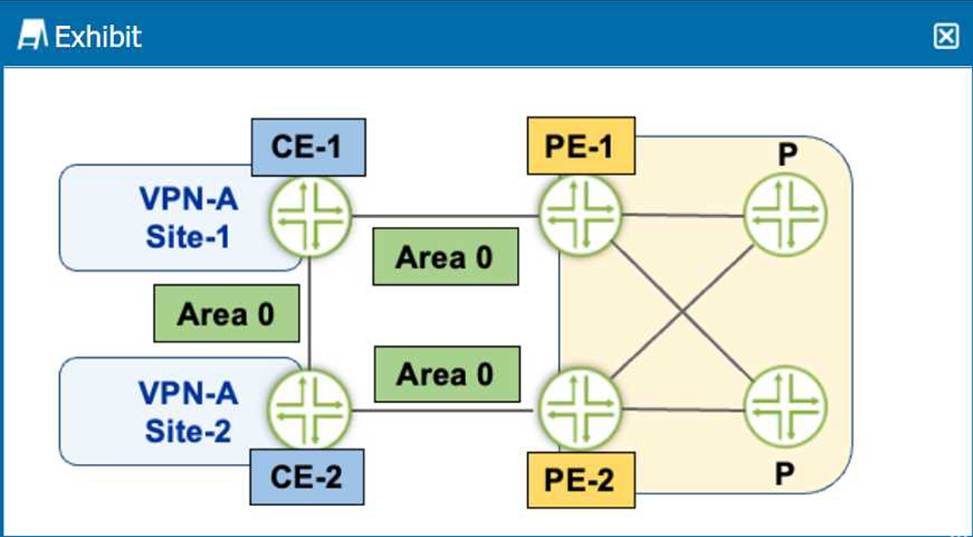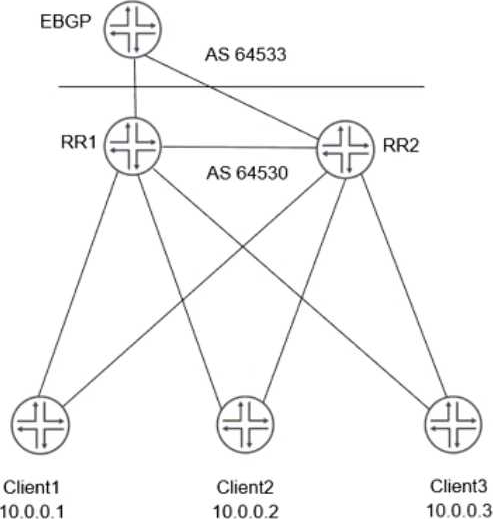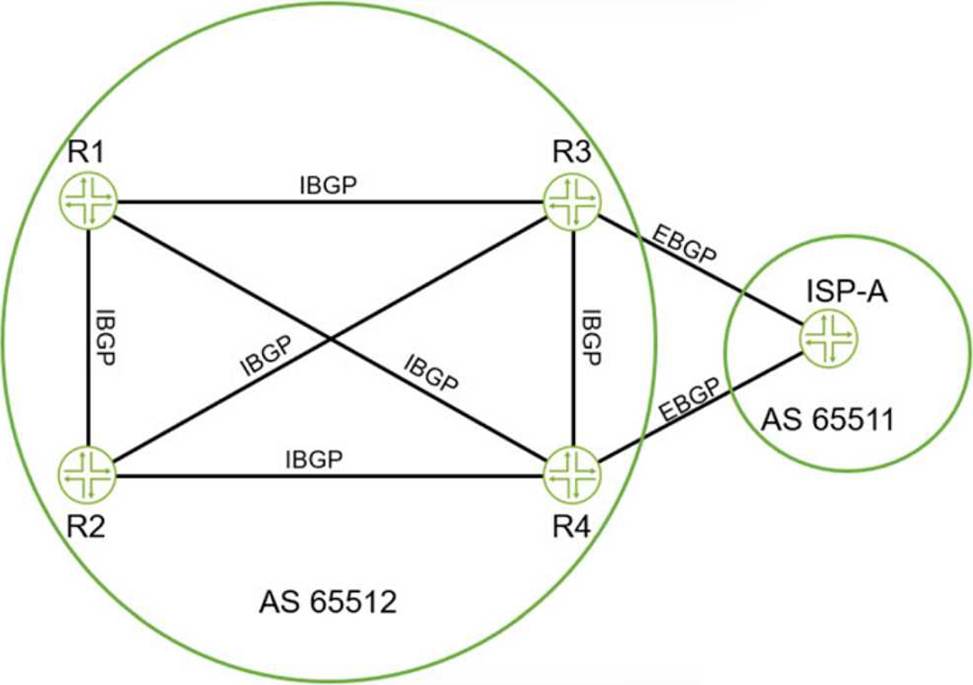Practice Free JN0-664 Exam Online Questions
Exhibit

R4 is directly connected to both RPs (R2 and R3) R4 is currently sending all ,o,ns upstream to R3 but you want all joins to go to R2 instead Referring to the exhibit, which configuration change will solve this issue?
- A . Change the bootstrap priority on R2 to be higher than R3
- B . Change the default route in inet.2 on R4 from R3 as the next hop to R2
- C . Change the local address on R2 to be higher than R3.
- D . Change the group-range to be more specific on R2 than R3.
D
Explanation:
PIM Bootstrap Router (BSR) is a mechanism that allows PIM routers to discover and announce rendezvous point (RP) information for multicast groups. BSR uses two roles: candidate BSR and candidate RP. Candidate BSR is the router that collects information from all available RPs in the network and advertises it throughout the network. Candidate RP is the router that wants to become the RP and registers itself with the BSR. There can be only one active BSR in the network, which is elected based on the highest priority or highest IP address if the priority is the same. The BSR priority can be configured manually or assigned automatically. The default priority is 0 and the highest priority is 2551
. In this question, R4 is directly connected to both RPs (R2 and R3) and is currently sending all joins upstream to R3 but we want all joins to go to R2 instead. To achieve this, we need to change the BSR priority on R2 to be higher than R3 so that R2 becomes the active BSR and advertises its RP information to R4.
Reference: 1: https://study-ccnp.com/multicast-rendezvous-points-explained/
Exhibit

R4 is directly connected to both RPs (R2 and R3) R4 is currently sending all ,o,ns upstream to R3 but you want all joins to go to R2 instead Referring to the exhibit, which configuration change will solve this issue?
- A . Change the bootstrap priority on R2 to be higher than R3
- B . Change the default route in inet.2 on R4 from R3 as the next hop to R2
- C . Change the local address on R2 to be higher than R3.
- D . Change the group-range to be more specific on R2 than R3.
D
Explanation:
PIM Bootstrap Router (BSR) is a mechanism that allows PIM routers to discover and announce rendezvous point (RP) information for multicast groups. BSR uses two roles: candidate BSR and candidate RP. Candidate BSR is the router that collects information from all available RPs in the network and advertises it throughout the network. Candidate RP is the router that wants to become the RP and registers itself with the BSR. There can be only one active BSR in the network, which is elected based on the highest priority or highest IP address if the priority is the same. The BSR priority can be configured manually or assigned automatically. The default priority is 0 and the highest priority is 2551
. In this question, R4 is directly connected to both RPs (R2 and R3) and is currently sending all joins upstream to R3 but we want all joins to go to R2 instead. To achieve this, we need to change the BSR priority on R2 to be higher than R3 so that R2 becomes the active BSR and advertises its RP information to R4.
Reference: 1: https://study-ccnp.com/multicast-rendezvous-points-explained/
Refer to the exhibit.

Click the Exhibit button.
Referring to the exhibit, the PE-to-CE protocol being used is OSPF for the L3VPN. Also, there is an OSPF neighborship between CE-1 and CE-2.
Which statement is correct in this situation?
- A . You must set a high metric on the CE-1 to CE-2 link for hosts at Site-1 to use the L3VPN to reach hosts at Site-2.
- B . Hosts at Site-1 will reach hosts at Site-2 through the CE-1 and CE-2 link by default.
- C . Hosts at Site-1 will reach hosts at Site-2 through the L3VPN by default.
- D . You must set a high metric on the CE-1 to PE-1 link for hosts at Site-1 to use the CE-1 to CE-2 link to reach hosts at Site-2.
B
Explanation:
In the exhibit, the PE-to-CE protocol used is OSPF, and there is an OSPF neighborship between CE-1 and CE-2 within the same Area 0. Let’s analyze the default OSPF routing behavior in this setup to determine the correct statement.
Exhibit

Referring to the exhibit, you are receiving the 192.168 0 0/16 route on both R3 and R4 from your EBGP neighbor You must ensure that R1 and R2 receive both BGP routes from the route reflector
In this scenario, which BGP feature should you configure to accomplish this behavior?
- A . add-path
- B . multihop
- C . multipath
- D . route-target
A
Explanation:
BGP add-path is a feature that allows the advertisement of multiple paths through the same peering session for the same prefix without the new paths implicitly replacing any previous paths. This behavior promotes path diversity and reduces multi-exit discriminator (MED) oscillations. BGP add-path is implemented by adding a path identifier to each path in the NLRI. The path identifier can be considered as something similar to a route distinguisher in VPNs, except that a path ID can apply to any address family. Path IDs are unique to a peering session and are generated for each network3. In this question, we have a route reflector (RR) that receives two routes for the same prefix (192.168.0.0/16) from an EBGP neighbor. By default, the RR will only advertise its best path to its clients (R1 and R2). However, we want R1 and R2 to receive both routes from the RR. To achieve this, we need to configure BGP add-path on the RR and enable it to send multiple paths for the same prefix to its clients.
Reference: 3: https://www.cisco.com/c/en/us/td/docs/ios-xml/ios/iproute_bgp/configuration/xe-16/irg-xe-16-book/bgp-additional-paths.html
Exhibit

Referring to the exhibit, which two statements are correct about the dual route reflectors within a cluster? (Choose two.)
- A . RR1 and RR2 must have the same duster ID to exchange routes learned from the client.
- B . RR1 and RR2 append the duster ID when advertising routes from dient to dient.
- C . RR1 and RR2 advertise routes learned from the clients to EBGP peers, using itself as the next hop.
- D . RR1 advertises routes from the client to RR2. using itself as the next hop.
Exhibit

Referring to the exhibit, which two statements are correct about the dual route reflectors within a cluster? (Choose two.)
- A . RR1 and RR2 must have the same duster ID to exchange routes learned from the client.
- B . RR1 and RR2 append the duster ID when advertising routes from dient to dient.
- C . RR1 and RR2 advertise routes learned from the clients to EBGP peers, using itself as the next hop.
- D . RR1 advertises routes from the client to RR2. using itself as the next hop.
Click the Exhibit button.

Referring to the exhibit, which two statements are correct about BGP routes on R3 that are advertised to R1? (Choose two.)
- A . By default, the next-hop value for these routes is changed by R3 before being sent to R 1.
- B . By default, all BGP attributes values must be removed before advertising the routes to R 1.
- C . By default, the BGP local-preference value that is assigned on R3 is advertised to R 1.
- D . By default, the next-hop value for these routes is not changed by R3 before being sent to R 1.
CD
Explanation:
In the exhibit, we see an internal BGP (iBGP) setup within AS 65512, and an external BGP (eBGP) connection between R3 and ISP-A (AS 65511). The questions focus on the behavior of BGP routes advertised from R3 to R1 within the same AS.
In IS-IS, which two statements are correct about the designated intermediate system (DIS) on a multi-access network segment? (Choose two)
- A . A router with a priority of 10 wins the DIS election over a router with a priority of 1.
- B . A router with a priority of 1 wins the DIS election over a router with a priority of 10.
- C . On the multi-access network, each router forms an adjacency to every other router on the segment
- D . On the multi-access network, each router only forms an adjacency to the DIS.
A,C
Explanation:
In IS-IS, a designated intermediate system (DIS) is a router that is elected on a multi-access network segment (such as Ethernet) to perform some functions on behalf of other routers on the same segment. A DIS is responsible for sending network link-state advertisements (LSPs), which describe all the routers attached to the network. These LSPs are flooded throughout a single area. A DIS also generates pseudonode LSPs, which represent the multi-access network as a single node in the link-state database. A DIS election is based on the priority value configured on each router’s interface connected to the multi-access network. The priority value ranges from 0 to 127, with higher values indicating higher priority. The router with the highest priority becomes the DIS for the area (Level 1, Level 2, or both). If routers have the same priority, then the router with the highest MAC address is elected as the DIS. By default, routers have a priority value of 64. On a multi-access network, each router only forms an adjacency to the DIS, not to every other router on the segment. This reduces the amount of hello packets and LSP
You want to ensure that a single-area OSPF network will be loop free.
In this scenario, what are two requirements that satisfy this requirement? (Choose two.)
- A . The DR/BDR ensures that each node within an area has the same information in their LSDBs.
- B . The Shortest Path First algorithm must prune looped paths.
- C . Nodes within an area must connect in a full mesh.
- D . All nodes within an area must have the same information in their LSDBs.
BD
Explanation:
To ensure that a single-area OSPF network is loop-free, two requirements that must be satisfied are A (DR/BDR ensures that each node within an area has the same information in their LSDBs) and D (all nodes within an area must have the same information in their LSDBs). These ensure that all routers have a consistent view of the network, which is essential for preventing loops.
You want to ensure that a single-area OSPF network will be loop free.
In this scenario, what are two requirements that satisfy this requirement? (Choose two.)
- A . The DR/BDR ensures that each node within an area has the same information in their LSDBs.
- B . The Shortest Path First algorithm must prune looped paths.
- C . Nodes within an area must connect in a full mesh.
- D . All nodes within an area must have the same information in their LSDBs.
BD
Explanation:
To ensure that a single-area OSPF network is loop-free, two requirements that must be satisfied are A (DR/BDR ensures that each node within an area has the same information in their LSDBs) and D (all nodes within an area must have the same information in their LSDBs). These ensure that all routers have a consistent view of the network, which is essential for preventing loops.
